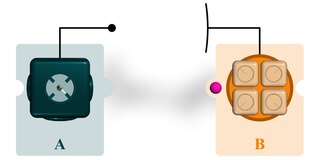Protocol
The simplest case: GHZ states
This example follows the original scheme laid out by Hillery et al. in 1998 which makes use of Greenberger–Horne–Zeilinger (GHZ) states. A similar scheme was developed shortly thereafter which used two-particle entangled states instead of three-particle states. [7] In both cases, the protocol is essentially an extension of quantum key distribution to two receivers instead of just one.
Following the typical language, let the sender be denoted as Alice and two receivers as Bob and Charlie. Alice's objective is to send each receiver a "share" of her secret key (really just a quantum state) in such a way that:
- Neither Bob's nor Charlie's share contains any information about Alice's original message, and therefore neither can extract the secret on their own.
- The secret can only be extracted if Bob and Charlie work together, in which case the secret is fully revealed.
- The presence of either an outside eavesdropper or a dishonest receiver (either Bob or Charlie) can be detected without the secret being revealed.
Alice initiates the protocol by sharing with each of Bob and Charlie one particle from a GHZ triplet in the (standard) Z-basis, holding onto the third particle herself:
where and are orthogonal modes in an arbitrary Hilbert space.
After each participant measures their particle in the X- or Y-basis (chosen at random), they share (via a classical, public channel) which basis they used to make the measurement, but not the result itself. Upon combining their measurement results, Bob and Charlie can deduce what Alice measured 50% of the time. Repeating this process many times, and using a small fraction to verify that no malicious actors are present, the three participants can establish a joint key for communicating securely. Consider the following for a clear example of how this will work.
Let us define the x and y eigenstates in the following, standard way:
- .
The GHZ state can then be rewritten as
- ,
where (a, b, c) denote the particles for (Alice, Bob, Charlie) and Alice's and Bob's states have been written in the X-basis. Using this form, it is evident that their exists a correlation between Alice's and Bob's measurements and Charlie's single-particle state:
if Alice and Bob have correlated results then Charlie has the state and if Alice and Bob have anticorrelated results then Charlie has the state .

It is clear from the table summarizing these correlations that by knowing the measurement bases of Alice and Bob, Charlie can use his own measurement result to deduce whether Alice and Bob had the same or opposite results. Note however that to make this deduction, Charlie must choose the correct measurement basis for measuring his own particle. Since he chooses between two noncommuting bases at random, only half of the time will he be able to extract useful information. The other half of the time the results must be discarded. Additionally, from the table one can see that Charlie has no way of determining who measured what, only if the results of Alice and Bob were correlated or anticorrelated. Thus the only way for Charlie to figure out Alice's measurement is by working together with Bob and sharing their results. In doing so, they can extract Alice's results for every measurement and use this information to create a cryptographic key that only they know.
((k,n)) threshold scheme
The simple case described above can be extended similarly to that done in CSS by Shamir and Blakley via a thresholding scheme. In the ((k,n)) threshold scheme (double parentheses denoting a quantum scheme), Alice splits her secret key (quantum state) into n shares such that any k≤n shares are required to extract the full information but k-1 or less shares cannot extract any information about Alice's key.
The number of users needed to extract the secret is bounded by n/2 < k ≤ n. Consider for n ≥ 2k, if a ((k,n)) threshold scheme is applied to two disjoint sets of k in n, then two independent copies of Alice's secret can be reconstructed. This of course would violate the no-cloning theorem and is why n must be less than 2k.
As long as a ((k,n)) threshold scheme exists, a ((k,n-1)) threshold scheme can be constructed by simply discarding one share. This method can be repeated until k=n.
The following outlines a simple ((2,3)) threshold scheme, [4] and more complicated schemes can be imagined by increasing the number of shares Alice splits her original state into:
Consider Alice beginning with the single qutrit state
and then mapping it to three qutrits
and sharing one qutrit with each of the 3 receivers. It is evident that a single share does not give any information about Alice's original state, since each share is in the maximally mixed state. However, two shares could be used to reconstruct Alice's original state. Assume the first two shares are given. Add the first share to the second (modulo three) and then add the new value of the second share to the first. The resulting state is
where the first qutrit is exactly Alice's original state. Via this method, the sender's original state can be reconstructed at one of the receivers' particles, but it is crucial that no measurements be made during this reconstruction process or any superposition within the quantum state will collapse.










































